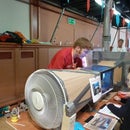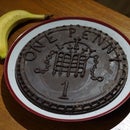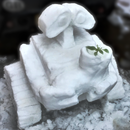Introduction: Focus a Telescope Using Tape
There are few things that are more frustrating than spending an evening taking photos of the heavens with your telescope, only to find that all of your photos are slightly out of focus...
Focussing a telescope for astrophotography is very difficult, the diffraction patterns around stars mean that they never really focus to a point; it is difficult to say when they are smallest, and difficult to keep track of which way the focus needs adjusting.
Fortunately Pavel Bahtinov invented a great solution back in 2005. The best way to achieve a sharp focus is to use a diffractive mask (a Bahtinov mask) to give great visibility of both how well focussed the telescope is and the direction with which it is out of focus.
You can buy these or make them yourself (I will write an instructable on laser cutting one as soon as I get around to lasering one myself!), but in this instructable I will show you how to use the principle to focus your telescope quickly, simply and almost for free... using only electrical tape.
For the avoidance of doubt, once the telescope is focussed, the tape is removed to give a sharp image.
For this you will require:
Some electrical tape. Any opaque tape that doesn't leave a gluey mess behind will work, but PVC electrical tape is what I use.
A reflector telescope. I used an 8 inch Schmidt Cassegrain (Nexstar 8SE), but it should work equally well with most Newtonians or Maks. You might be able to do this with a refractor but it is less easy and risks getting the tape on the lens.
A camera with suitable adapter. Not strictly necessary, as you can focus for direct viewing with this technique. I used a Sony Alpha a6000 on a 1.25" eyepiece adapter.
Note: Telescopes are fragile, so don't go putting big forces on things or you'll de-collimate (or worse) your telescope!
All photos are from my telescope, focussed using this method, and not photoshopped beyond brightness/contrast adjustment (not even photo stacking)
Step 1: Carefully Add Strips of Tape to Form a 'Y'
Tear a strip of tape slightly longer than the radius of your telescope. Very gently stick one end of this to the centre secondary support with the tape held taut horizontally coming out to the rim at the 9 o'clock position. At all times make sure the tape is held away from the corrector plate lens to avoid getting any residue on the lens. Stick the far end carefully on the rim with the tape taut enough to bridge without touching the corrector, while being careful not to pull hard enough to either unstick the tape or affect collimation of the secondary.
In the same way, carefully add two pieces of tape to the other side, angled around 20° either side of horizontal (i.e. below 2 o'clock and above 4 o'clock). See the pictures for details.
If attempted on a refractor, this Y would need adding in one go!
Step 2: Add Further Strips to Create Narrow Slots
Now add 4 more strips, two each side, parallel with the previous strips.
The aim here is to form two horizontal slots approximately 5m wide one side, and two angled slots (again 5mm wide) the other side. It is important to get the tape as parallel as possible such that the slot is constant width all the way along. The exact width of the slot is less critical. Again see the image for details.
If attempted on a refractor a small vertical length of tape would be needed to tie all the tape together in the middle so it is held taut. I haven't tried this, and expect this would be tricky but not impossible!
Step 3: Point the Telescope at a Bright Star and Coarsely Focus
Point the telescope at a bright star. Polaris may be a good choice if you don't have a tracking mount. Centre the star in the camera's view and focus the telescope until the star looks like a spiky white dot. If you have a focus-assist magnifier view, use it now to make things easier to see.
The spikes are caused by the narrow slots diffracting the star light. The side with the horizontal slots makes a vertical 'I' spike, while the two angled slots make two angled spikes forming an 'X'. As the focus is changed near the optimal focus, the I and X slide sideways relative to each other.
Adjust the focus until they overlap, noting which way the I moves when the focuser is turned clockwise.
Step 4: Make Fine Adjustments to Centre the I Within the X
As you get closer to centralised, you will have to visualise the crossing point of the two spikes that form the X, and try to get the I as well centred as possible. This will require minute changes, and you'll need to wait for the vibrations to settle after each adjustment.
Fortunately, with this method you have a good read out which way the focuser needs turning, and how far from perfection you are. You will notice that the adjustments become far finer than you'd be making focussing by eye as this method gets a very accurate focus.
Once you cannot centre things any better you have achieved a really good focus! Carefully remove the tape so you no longer get the diffraction spikes.
Step 5: Take Some Awesome, in Focus Photos!
Here's the pay off... you get to take awesome photos of whatever you fancy!
I'm pleased with these photos.
They are of:
- M65, M66 from the Leo Triplet
- M51 Whirlpool Galaxy in Canes Venatici
- M42 Orion Nebula
- The Moon
All four are in perfect focus. Any apparent blur will be down to at least one of: atmospheric distortion (poor seeing), tracking error (over 10-30s exposures on an Alt-Az mount), overexposure of stars, or the diffraction limit of resolution of my telescope.
Still they aren't bad for single photos taken in my back garden with a telescope I can easily lift! If you want to eliminate tracking error and some atmospheric distortion, stacking multiple short exposures can improve quality significantly.
I hope you have found this instructable interesting/useful. If so please vote for me in the Tape Contest!

Third Prize in the
Tape Contest













